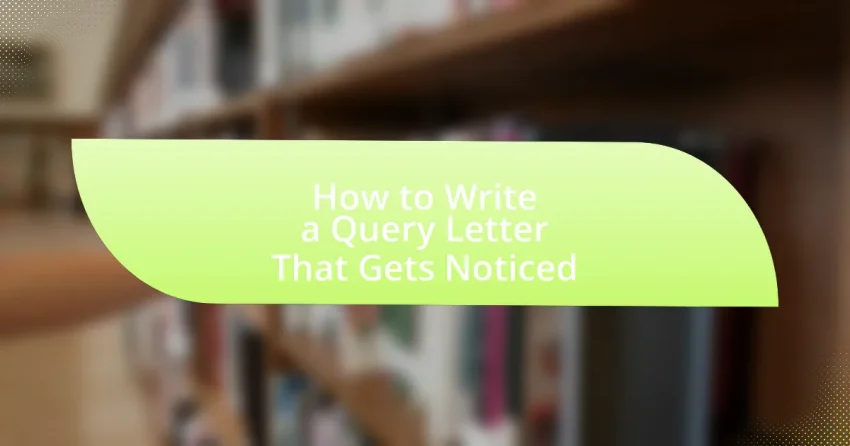A query letter is a formal communication from an author to a literary agent or publisher, proposing a manuscript for consideration. This article outlines the importance of a well-crafted query letter, detailing its key elements such as a compelling hook, a brief synopsis, and author credentials. It also highlights common mistakes to avoid, the significance of personalization, and best practices for structuring and formatting the letter. Additionally, the article provides techniques for creating an engaging opening, tips for following up, and resources for further guidance, all aimed at increasing the chances of securing representation or publication.

What is a Query Letter and Why is it Important?
A query letter is a formal communication sent by an author to a literary agent or publisher to propose a manuscript for consideration. It is important because it serves as the first impression of the author’s work, providing a concise summary of the manuscript, its target audience, and the author’s credentials. A well-crafted query letter can significantly increase the chances of securing representation or publication, as agents and publishers often receive numerous submissions and rely on query letters to filter potential projects. According to the Association of Authors’ Representatives, a strong query letter can lead to requests for full manuscripts, highlighting its critical role in the publishing process.
How does a query letter differ from other types of correspondence?
A query letter differs from other types of correspondence primarily in its purpose and structure, as it is specifically designed to pitch a creative work, such as a manuscript, to agents or publishers. Unlike general correspondence, which may serve various functions like casual communication or information sharing, a query letter is formal and concise, focusing on presenting the work’s concept, target audience, and the author’s credentials. This targeted approach is essential in the publishing industry, where agents receive numerous submissions and require clear, compelling pitches to consider a project.
What are the key elements that make up a query letter?
The key elements that make up a query letter include a compelling hook, a brief synopsis of the work, author credentials, and a professional closing. A compelling hook captures the reader’s attention immediately, while the synopsis provides a concise overview of the plot or main idea, typically in one to three paragraphs. Author credentials establish the writer’s qualifications and relevance to the subject matter, enhancing credibility. Finally, a professional closing includes a polite thank you and the author’s contact information, ensuring clarity and professionalism. These elements collectively create a strong query letter that effectively communicates the writer’s intent and work.
Why is a query letter crucial for authors seeking representation?
A query letter is crucial for authors seeking representation because it serves as the initial point of contact with literary agents or publishers, effectively summarizing the author’s work and intent. This letter must capture attention quickly, as agents receive numerous submissions and often make decisions based on the query alone. A well-crafted query letter can demonstrate the author’s professionalism, understanding of the market, and ability to communicate their story succinctly, which are all essential factors in securing representation. According to the Association of Authors’ Representatives, a compelling query letter can significantly increase an author’s chances of receiving a request for a manuscript, highlighting its importance in the representation process.
What are the common mistakes to avoid in a query letter?
Common mistakes to avoid in a query letter include failing to personalize the letter, which can lead to a lack of connection with the recipient. Many writers neglect to research the agent or publisher, resulting in generic queries that do not align with their preferences. Additionally, errors in grammar and spelling can undermine professionalism, as noted in industry guidelines. Overly lengthy letters can also detract from the main message, as agents typically prefer concise communication. Lastly, not including a strong hook or compelling premise can fail to capture interest, as highlighted by successful query letter examples.
How can poor formatting impact the effectiveness of a query letter?
Poor formatting can significantly diminish the effectiveness of a query letter by making it difficult for agents or editors to read and assess the content. When a query letter lacks proper structure, such as clear paragraphs, appropriate font size, and consistent spacing, it can create a negative first impression, leading to the perception that the writer is unprofessional or careless. Research indicates that agents often make quick judgments based on the visual presentation of a submission; for instance, a study by the Association of Authors’ Representatives found that 70% of agents consider formatting as a critical factor in their decision-making process. Therefore, adhering to standard formatting guidelines is essential for capturing attention and conveying professionalism.
What are the pitfalls of using generic templates for query letters?
Using generic templates for query letters can lead to a lack of personalization, which diminishes the impact of the letter. Personalization is crucial in query letters because agents and publishers receive numerous submissions and are more likely to respond positively to letters that demonstrate a genuine understanding of their preferences and interests. Generic templates often fail to address specific guidelines or preferences outlined by the recipient, resulting in a higher likelihood of rejection. Additionally, reliance on templates can lead to a formulaic tone that does not reflect the unique voice of the writer, making it harder for the query to stand out. Research indicates that tailored submissions significantly increase the chances of acceptance, as they show effort and engagement with the recipient’s work.

How to Structure a Query Letter Effectively?
To structure a query letter effectively, begin with a professional salutation, followed by a concise introduction that includes the title of your work, its genre, and word count. Next, provide a brief synopsis of your manuscript, highlighting the main characters, conflict, and unique elements that set your story apart. After the synopsis, include a short author bio that showcases relevant writing credentials or experiences. Finally, close with a polite thank you and your contact information. This structure is validated by industry standards, as agents and publishers often seek clarity and professionalism in query letters to assess submissions quickly.
What are the essential components of a successful query letter?
A successful query letter includes several essential components: a compelling hook, a brief synopsis of the work, author credentials, and a professional closing. The hook captures the reader’s attention immediately, making it crucial for engagement. The synopsis provides a concise overview of the plot or main ideas, typically one to two paragraphs, allowing the agent or editor to understand the work’s essence. Author credentials highlight relevant experience or previous publications, establishing credibility. Finally, a professional closing includes a polite thank you and contact information, ensuring a respectful and formal end to the letter. These components collectively enhance the letter’s effectiveness in attracting interest from agents or publishers.
How should you craft a compelling opening paragraph?
To craft a compelling opening paragraph for a query letter, start with a strong hook that captures the reader’s attention, such as an intriguing question or a bold statement about your work. This approach engages the reader immediately and sets the tone for the rest of the letter. For instance, stating a unique aspect of your story or a surprising fact can pique interest. Research indicates that query letters with engaging openings are more likely to receive positive responses, as they create an emotional connection and encourage further reading.
What information should be included in the synopsis section?
The synopsis section should include a concise summary of the main plot, key characters, and the central conflict of the work. This summary must clearly outline the beginning, middle, and end of the story, providing insight into character development and thematic elements. Including specific details about the protagonist’s journey and the resolution of the conflict enhances clarity and engages the reader. A well-crafted synopsis typically ranges from 500 to 1,000 words, ensuring it is succinct yet comprehensive enough to convey the essence of the narrative.
How can you personalize your query letter for specific agents?
To personalize your query letter for specific agents, research each agent’s preferences and interests, then tailor your letter to reflect those insights. This involves mentioning specific works by the agent that resonate with your project, aligning your book’s themes with the agent’s known tastes, and addressing the agent by name to create a personal connection. For instance, if an agent has expressed interest in contemporary romance, highlight how your manuscript fits within that genre and reference similar titles they have represented. Personalization increases the likelihood of engagement, as agents are more inclined to respond to queries that demonstrate a clear understanding of their individual preferences and professional background.
What research should you conduct before addressing an agent?
Before addressing an agent, you should conduct research on the agent’s submission guidelines, areas of interest, and recent sales. Understanding submission guidelines ensures that your query letter meets the agent’s specific requirements, which can vary significantly among agents. Researching the agent’s areas of interest allows you to tailor your pitch to align with their preferences, increasing the likelihood of capturing their attention. Additionally, reviewing recent sales helps you identify the types of projects the agent is currently representing, providing insight into their market focus and potential fit for your work. This targeted research enhances the effectiveness of your query letter and demonstrates professionalism.
How can you demonstrate your knowledge of the agent’s preferences?
You can demonstrate your knowledge of the agent’s preferences by tailoring your query letter to reflect their specific interests and submission guidelines. Researching the agent’s recent projects, preferred genres, and any stated preferences on their website or social media can provide insights. For instance, if an agent has expressed a preference for character-driven narratives in contemporary fiction, highlighting how your work aligns with that focus will show that you understand their tastes. This targeted approach not only showcases your awareness of the agent’s preferences but also increases the likelihood of your query being well-received.

What Techniques Can Make Your Query Letter Stand Out?
To make your query letter stand out, employ techniques such as personalizing the greeting, crafting a compelling hook, and showcasing your unique voice. Personalization demonstrates that you have researched the agent or publisher, which increases the likelihood of engagement. A compelling hook captures attention within the first few sentences, making your story memorable. Additionally, showcasing your unique voice allows your personality to shine through, differentiating your work from others. These techniques are supported by industry standards, as agents often receive hundreds of queries and prioritize those that immediately resonate with them.
How can you create a hook that captures attention?
To create a hook that captures attention, start with a compelling statement or question that resonates with the reader’s interests or emotions. This approach is effective because it immediately engages the audience and prompts them to think or feel something relevant. For instance, using a surprising statistic or a provocative question can pique curiosity and encourage further reading. Research shows that hooks that evoke strong emotions or present intriguing scenarios significantly increase engagement rates, as evidenced by studies in marketing psychology that highlight the importance of emotional connection in communication.
What are examples of effective hooks in query letters?
Effective hooks in query letters include intriguing opening lines that capture the reader’s attention immediately. For instance, starting with a provocative question related to the book’s theme can engage the agent or editor, such as “What if you discovered a secret that could change your life forever?” Another example is using a compelling statement that highlights the uniqueness of the story, like “In a world where dreams can be stolen, one girl fights to reclaim her future.” These hooks are effective because they create curiosity and set the tone for the narrative, making the reader eager to learn more about the manuscript.
How does tone and voice play a role in engaging the reader?
Tone and voice significantly engage the reader by establishing a connection and conveying the writer’s personality. A consistent tone, whether formal, conversational, or humorous, helps to create an emotional resonance, making the content relatable and memorable. For instance, a study by the University of California found that readers are more likely to respond positively to texts that reflect a friendly and approachable tone, as it fosters trust and encourages further interaction. This engagement is crucial in query letters, where capturing the reader’s attention quickly can determine the success of the communication.
What role does professionalism play in a query letter?
Professionalism in a query letter establishes credibility and demonstrates respect for the recipient. A well-structured, error-free letter reflects the writer’s commitment to quality, which is essential in the competitive publishing industry. According to a survey by the Editorial Freelancers Association, 70% of agents and editors prioritize professionalism in query letters, indicating that a polished presentation can significantly influence their decision-making process.
How can you ensure your query letter is free of errors?
To ensure your query letter is free of errors, meticulously proofread the document multiple times. This involves checking for spelling, grammar, and punctuation mistakes, as well as ensuring clarity and coherence in your writing. Utilizing tools like grammar checkers can help identify issues, but manual proofreading is essential for catching nuanced errors that software may miss. Additionally, having a trusted peer review your letter can provide fresh insights and catch mistakes you might overlook. Research indicates that documents reviewed by multiple individuals have a significantly lower error rate, enhancing overall quality.
What formatting tips can enhance the professionalism of your letter?
To enhance the professionalism of your letter, use a clean, structured format that includes a standard business letter layout. This layout typically features your address at the top, followed by the date, the recipient’s address, a formal greeting, the body of the letter, a closing, and your signature. Additionally, maintain consistent font usage, such as Times New Roman or Arial in 12-point size, and ensure proper margins of one inch on all sides. These formatting choices contribute to readability and convey respect for the recipient, which is crucial in professional correspondence.
What are the best practices for following up on a query letter?
The best practices for following up on a query letter include waiting an appropriate amount of time, typically 4 to 6 weeks, before sending a follow-up email. This timeframe allows agents or editors sufficient time to review submissions. In the follow-up, it is essential to be polite and concise, reiterating your interest in the project and inquiring about the status of your query. Additionally, referencing the original query letter can provide context and remind the recipient of your submission. According to industry standards, maintaining professionalism in tone and content is crucial for fostering positive relationships with literary agents or publishers.
How long should you wait before sending a follow-up email?
You should wait about one to two weeks before sending a follow-up email. This timeframe allows the recipient sufficient time to review your initial email or query letter, as industry standards suggest that most professionals require this duration to respond. According to a survey by the email marketing platform Yesware, 70% of professionals expect a follow-up after one week if they haven’t responded. This evidence supports the recommendation of waiting one to two weeks for an effective follow-up.
What should you include in a follow-up message to an agent?
In a follow-up message to an agent, you should include a polite reminder of your previous correspondence, a brief update on your project, and an expression of continued interest in their feedback. This structure helps maintain professionalism and clarity, which are essential in the publishing industry. For instance, stating the title of your work and the date of your initial query reinforces context and shows respect for the agent’s time. Additionally, mentioning any relevant developments, such as awards or new submissions, can enhance your message’s impact by demonstrating progress and commitment.
What are some final tips for writing a query letter that gets noticed?
To write a query letter that gets noticed, focus on crafting a compelling hook in the opening sentence that captures the agent’s attention. A strong hook can be a unique premise, an intriguing character, or a high-stakes situation that sets your work apart. Additionally, personalize each query letter by addressing the agent by name and mentioning why you chose to query them specifically, which demonstrates your research and genuine interest. Furthermore, keep the letter concise, ideally one page, and ensure it includes a brief synopsis of your work, your writing credentials, and any relevant publishing history. According to the Association of Authors’ Representatives, a well-structured query letter can significantly increase the chances of a positive response from agents.
How can feedback from peers improve your query letter?
Feedback from peers can significantly enhance your query letter by providing diverse perspectives and constructive criticism. Peers can identify unclear language, suggest stronger phrasing, and highlight areas that may lack engagement, which are crucial for capturing the attention of agents or publishers. Research indicates that collaborative feedback often leads to improved writing quality, as it allows for the incorporation of multiple viewpoints and expertise. For instance, a study published in the Journal of Writing Research found that peer review processes can lead to a 20% increase in the effectiveness of written communication. This demonstrates that peer feedback not only refines the content but also boosts the overall impact of the query letter.
What resources are available for further guidance on query letters?
Resources available for further guidance on query letters include books, online articles, and writing workshops. Notable books such as “The Writer’s Guide to Query Letters” by A.J. Jacobs and “Query Letters That Worked” by the Editorial Freelancers Association provide structured insights and examples. Online platforms like Writer’s Digest and The Balance Careers offer comprehensive articles detailing best practices and common pitfalls in query letter writing. Additionally, workshops hosted by writing organizations, such as the Association of Authors’ Representatives, provide interactive learning experiences and personalized feedback on query letters.
